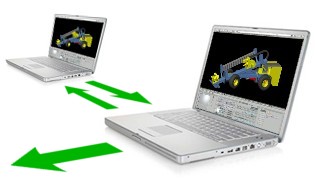Difference between revisions of "Open collaborative design"
(→Methods of turning collaborative designs into real objects) |
(→Methods of turning collaborative designs into real objects) |
||
| Line 17: | Line 17: | ||
== Methods of turning collaborative designs into real objects == | == Methods of turning collaborative designs into real objects == | ||
| − | To be useful to anyone these designs need to turned into physical objects which unfortunately isn't quite as straightforward as compiling software or downloading it over the internet. See [[methods | + | To be useful to anyone these designs need to turned into physical objects which unfortunately isn't quite as straightforward as compiling software or downloading it over the internet. See [[methods for turning collaborative designs into real objects]] for some different methods that might be used to give a design physical form. |
Revision as of 20:49, 28 January 2006
Open design takes the open source software development model and applies it to the design of physical artifacts and systems. Open source is now very prominent in the world of software creation. In this model networks of people connected by the internet collaborate to evolve software and make it freely available to others. Not only is the product available to use, but so are the workings of the software known as the source code. Anyone can customize and improve open-source software, making these changes available to others encourageing rapid development times and robustness.
Contents
Beyond software
This methodology is not limited to software. A noteable example beyond software are 'open content' projects such as Wikipedia, the well known collaborative encyclopedia which is accessible and editable by anyone with a web browser. Started in 2001 it is now the largest encyclopedia in the world, grown organically by thousands of users, and the overall quality of articles is surprisingly good. [1]
With a few built-in mechanisms to make sure the project doesn't dissolve into total chaos, the result is that this pool of knowledge is assembled and edited by people who want to do it. No-one is paying them to do it and no-one is telling them to do it, they do it because they want to. It feels like the right thing to do - they are contributing to something greater. Contributors' know their efforts will be used and appreciated by thousands of other people, and that others are doing likewise.
Applying Open Source methodology to the physical world
There is no reason why open source development methods cannot be applied to machines and systems in the physical world too. The simplest method is to share information through a website on how to make things using text, diagrams and photographs. A more sophisticated way to collaborate on complex machinery and products would be to share CAD assemblies over the internet much like project teams do in engineering and product design companies, knitted together with supporting information in an open and freely structured environment, much like a wiki.
There are certain barriers to overcome for open design when compared to software development where there are mature and widely used tools available and the duplication and distribution of code cost next to nothing. Creating, testing and modifying physical designs is not quite so straightforward because of the effort and time required to create the physical artifact.
Suitable CAD software
It is likely that at some point advanced open-source CAD software with built-in physics engines and the ability to model kinematics will aid engineers and designers greatly in this respect by allowing a lot of testing to be done virtually. The availability of user-friendly open source CAD software will be essential to this field, along with open standards for associated file formats, and file converters to extract data from assemblies created with proprietary CAD packages.
Methods of turning collaborative designs into real objects
To be useful to anyone these designs need to turned into physical objects which unfortunately isn't quite as straightforward as compiling software or downloading it over the internet. See methods for turning collaborative designs into real objects for some different methods that might be used to give a design physical form.
